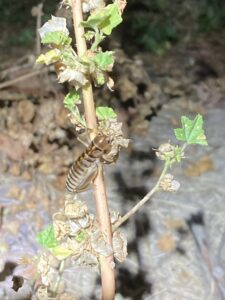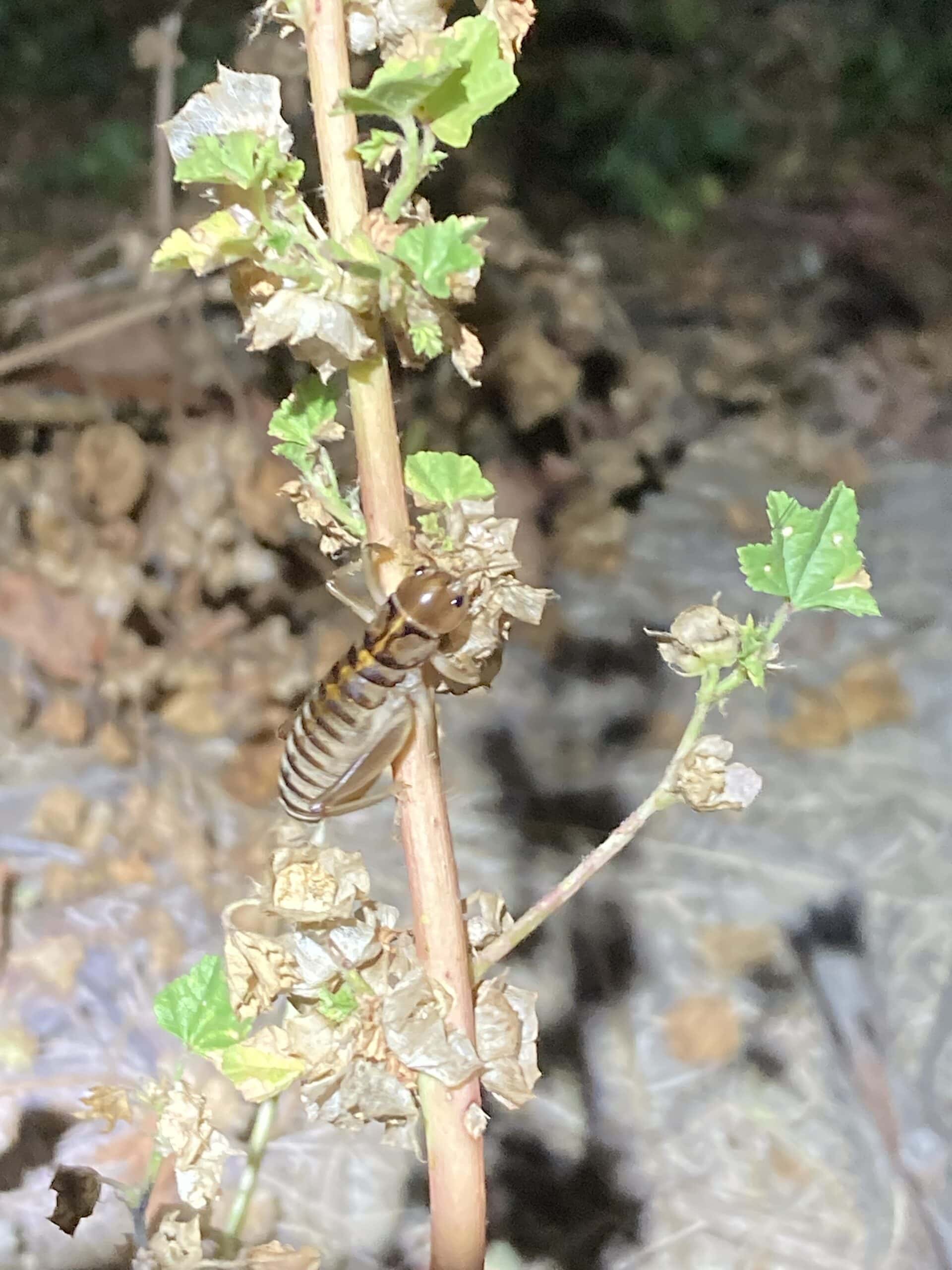Jessica Vereijssen, Mette Nielsen, Roger Wallis, Richard Hunter, Stewart Graham (Plant & Food Research), Mary Morgan-Richards, Nyasha Chikwature, and Steve Trewick (Massey University)

Wētā foraging at night on a weed in the vineyard in February 2023
The endemic ground wētā, Hemiandrus bilobatus, lives in burrows in the soil. Its presence can negatively affect wine grape production, especially in vineyards in the Awatere region of Marlborough. Vine growth in early spring provides the ground wētā with a buffet of fresh buds to feed upon, which causes damage detrimental to vine growth and fruit yield.
The current ground wētā management tool sees plastic sleeves wrapped around vine trunks to prevent wētā from accessing the cordon. However, the sleeves are costly to install and maintain, resulting in a significant waste-management issue.
This project, which started in July 2022, seeks to understand the wētā–vine association and develop environmentally sustainable solutions where vineyards and the ground wētā can co-exist. It is funded by New Zealand Winegrowers and led and managed by the Bragato Research Institute (BRI). It also brings together Plant & Food Research (PFR) and Massey University scientists. The wider project team includes grower representatives from local wineries to ensure that any proposed solutions are practical and financially sustainable.
Progress over the past year
Engaging with mana whenua
We engaged with mana whenua and growers to get to know them, introduce the project, and find suitable trial site locations. Engagement with mana whenua was not straightforward, as the Awatere area had no permanent Māori settlements, only seasonal ones, and was mainly used as a pathway.
We engaged with Māori to write a piece about Mātauranga Māori, Te Ao Māori, and Te Aitanga Pepeke, the world of insects. We learned that the wētā existed approximately 190 million years ago. Kupu Māori spoke of tokoriro, punga, motu, and wētā. The name taipo (wētā) was also used as a definition, meaning the devil that comes out at night.
The Kaikōura coastline provided a pathway north and south through easy beach access. Maara kai sites were developed and located on the lower seaward terraces, Clarence/Kekerengu. Rangitane ki Wairau at Te Para Hou (Grassmere) and Ngai Tahu/ Ngati Rūnanga o Kaikōura at Waiharakeke (Ure River) were resting places when travelling north or south. Maara kai e noho and papakāinga were not located in the Awatere, possibly due to dry, wind-blown loess soils unsuitable for sustainable gardens.
Under cultivated or maara kai situations, wētā would not have been a concern. If located, wētā would have been disposed of as a “possible” prime source of kai. Māori were pragmatic, turning ‘pests’ into resources for other purposes. This suggests that hōhā riha (nuisance pests) were experienced and managed differently from today.
Understanding wētā in vineyards
Our work addressed two main research areas. The first was conducting interviews to understand the breadth of the problem and identify possible solutions. Eleven in-person interviews were undertaken to assess wētā distribution, the extent to which wētā are a problem, what the people had observed in their vineyards, what differences they had observed within the Awatere, and any control solutions people were thinking of or had trialled. From the interviews, we could not identify a situation or variable that made vineyards prone to wētā damage. The discussions have, however, given us insights into possible solutions and provided a research focus for year two.

Surveying during the day by digging up wētā burrows
The second main research area was the survey of selected vineyards during budburst (in September and October 2022 to capture the early and late budburst varieties) and outside the budburst period (February 2023). Surveying for H. bilobatus in vineyards was conducted during the daytime (Figure 2) and in the evening (from just after sunset till about 10:30 pm), and specimens were collected for diet analysis.
Despite low temperatures, wētā were active (i.e., out of their burrows) early in the evenings during the budburst surveys. A marked increase in activity and numbers of juvenile and adult wētā were observed in the February 2023 survey.
Deliberate removal of wētā guards in a vineyard over four weeks during budburst clearly demonstrated the potential severity of damage by the wētā at budburst, with over 70% of the buds destroyed and an additional 24% of the buds damaged to some degree.
A PhD student joins the team
In December 2022, Nyasha Chikwature started her PhD studies within this project. She joined the Massey team in the field in Wairarapa in December and the PFR team in Awatere in February and collected the first ground wētā for her studies.
Nyasha has conducted a literature review to understand the ecology of endemic insect species that have become horticultural and agricultural problems in New Zealand. She also analysed the diet of ground wētā species related to H. bilobatus living in their natural forest habitat: H. electra, H. ‘disperalis’, and H.nox from the St Arnaud area.
The results of the studies showed that H. ‘disperalis’ and H. electra had 80% plant material in their guts and 20% invertebrate material, while H. nox had 80% invertebrate material and 20% plant material. Overall, the results showed that although the three species were collected from the same traps and at the same time of the year, the basic constitution of their diets differed. Nyasha presented her results at the New Zealand Entomological Society Conference in Tāmaki Makaurau Auckland in August 2023.
Related research
Three related areas of research worth noting are:
- Field surveys in the Wairarapa in December 2022 showed H. bilobatus was found in native regenerative bush but not in vineyards. Night observations of H. bilobatus at Tora (near Martinborough) in the native regenerating forest during January 2023 confirmed foraging activity close to the ground and climbing tree trunks. We observed wētā eating grass seeds and collected specimens for diet analysis to compare with H. bilobatus foraging in vineyards in the Awatere.
- We responded to information on wētā damage to vines outside the Awatere area. Wētā burrows were confirmed, and species were collected from Waipara and the Wairau Valley. The Waipara specimen is still unknown; the Wairau Valley specimens were identified as H. taygete. This is the first time evidence of related ground wētā damaging vines had been collected.
- We conducted laboratory trials that showed that H. bilobatus males and females preferred high soil moisture levels (60-80% of field capacity) and less compacted soils (0.9 to 1.0 g/cm3 bulk density), with the males choosing the more compacted soil. This is in line with what was observed in the vineyards, with most burrows located from right under the drip irrigation lines about 300 mm away from the drip lines, independent of vineyard location and grape variety.
Focus for this year
With the project team, the BRI project management team, and industry partners, we reviewed and discussed the results for year one of the project and prioritised research to go forward in the project’s second year. The main research topics for the team are to investigate 1. the use of deterrents to manage ground wētā damage, 2. the effect of cover crops and RollHacke roller weeder (under vine cultivation) on wētā presence and damage, and 3. the effect of subsurface irrigation on wētā presence in vineyards.
About the project
This three-year project is funded through the New Zealand Wine Futures Fund, managed, and launched in 2021 by BRI to bring new and novel ideas to levy-funded research. It is funded through New Zealand Winegrowers’ levies and is project-managed by BRI. The wētā project has co-funding from Indevin, Pernod-Ricard, Yealands, Constellation, and Hortus to support the Massey University PhD student. The science team is led by PFR, with significant in-kind contributions from Massey University.

















